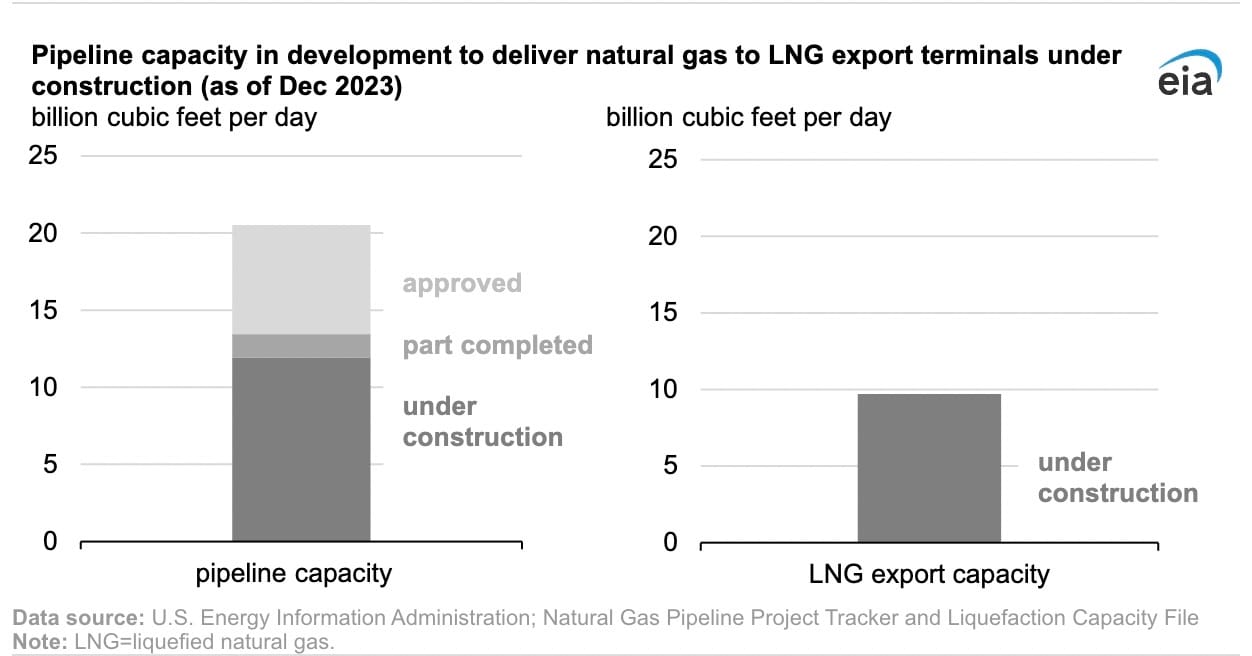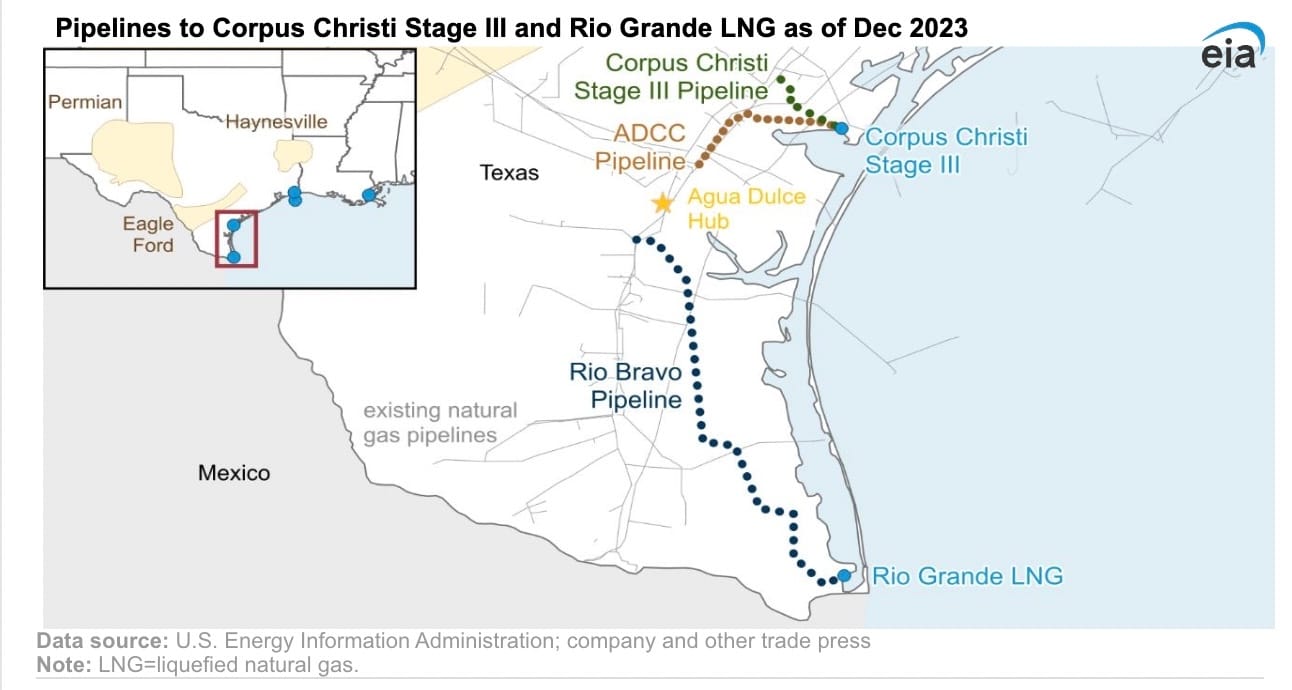Welcome to Grid Brief! Here’s what we’re looking at today: America’s big pipeline build to LNG export terminals, COP 28 okays more nuclear, and more.
Pipelinin’ 2: American LNG Boogaloo

The US has been a natural gas juggernaut since the fracking boom. But now it has grown into the Hercules of LNG—and it has the pipeline buildout to prove it.
“More than 20.0 billion cubic feet per day (Bcf/d) of natural gas pipeline capacity is under construction, partly completed, or approved to deliver natural gas to five U.S. liquefied natural gas (LNG) export terminals that are currently under construction,” reports the Energy Information Administration.
Let’s run through what the EIA is tracking.

Southeast Texas is getting two pipelines. The first is the Golden Pass Pipeline. The company behind it is making changes to an existing 69-mile pipeline. This alteration will allow the pipeline to carry more natural gas—about 2.5 billion cubic feet per day—to the Golden Pass LNG terminal in Jefferson County, Texas. The pipeline was initially built in 2010 to transport imported natural gas to other pipelines and markets up North. Now, it's being made to flow south and connect to nearby sources of natural gas.
The second pipeline project is the Louisiana Connector Project and Texas Connector Project, developed by the The Port Arthur Pipeline Company. The project involves two pipelines, each capable of transporting 2.0 billion cubic feet of natural gas per day. These pipelines will supply natural gas to the Port Arthur LNG export terminal in Jefferson County, Texas. .
All of the Louisiana projects are flowing into the Plaquemines LNG terminal. The first is the Gator Express Pipeline. Its developer, Venture Global Gator Express, is building two pipelines, each capable of carrying around 2.0 billion cubic feet of natural gas per day. The second is the Evangeline Pass Expansion Project. Its developer, the Tennessee Gas Pipeline Company, intends to construct a 13-mile pipeline with a capacity of 1.1 billion cubic feet of natural gas per day. Lastly, Texas Eastern Transmission’s Venice Extension Project is building a three-mile pipeline with a capacity of 1.3 billion cubic feet of natural gas per day.

Now for South Texas: The ADCC Pipeline, developed by WhiteWater Midstream, is constructing a 39-mile pipeline with a capacity of 1.7 billion cubic feet of natural gas per day. This pipeline will transport natural gas from the end of the Whistler Pipeline, in the Eagle Ford shale region, to the Corpus Christi Stage III project. The there’s the Corpus Christi Stage III Pipeline with a capacity of 1.5 billion cubic feet of natural gas per day. Third comes the Rio Bravo Pipeline, which will features two pipelines totaling 138 miles with a combined capacity of 4.5 billion cubic feet of natural gas per day. These pipelines will move natural gas from Agua Dulce to the Rio Grande LNG terminal.
COP 28 Calls for More Nuclear

Downtown Dubai. Photo by David Rodrigo on Unsplash
COP 28 finally reached an agreement on what the “energy transition” should look like. For years, nuclear energy advocates weren’t allowed to attend COP. Now, nuclear has found its place in the global green energy future—the COP 28 Global Stocktake calls for an “acceleration” of carbon free technologies, the fission included.
It wasn’t easy to get nuclear included in the text. Germany pushed to exclude it, which shouldn’t surprise our Premium subscribers—Monday’s Grid Brief International took a hard look at the origins of anti-nuclearism in Germany and the folly of their renewables-only climate policy.
But what does this mean for the global energy picture? It’s unclear. Certainly, nuclear’s inclusion suggests it is no longer the blacksheep of clean energy. But the Stocktake Agreement also called for the tripling of global renewable energy capacity and “recognizes that transitional fuels can play a role in facilitating the energy transition while ensuring energy security.” In other words, natural gas is here to stay. The agreement gives everyone something to praise and condemn—that’s politics.
Upgrade to Grid Brief Premium to get extra deep dives into energy issues all over the world.
Conversation Starters
The North American Electric Reliability Corp. risks missing the deadline for winterization standards. “Extreme cold remains a potential reliability issue for generators but work to finalize new weatherization standards has stalled with a recent failed vote by stakeholders, the North American Electric Reliability Corp. Board of Trustees said Tuesday,” reports Utility Dive. “In February, the Federal Energy Regulatory Commission directed NERC to strengthen cold weather generator requirements contained in Reliability Standard EOP-012-1. But proposed updates have so-far failed to garner support from NERC’s members, meaning the board may have to take action on its own, Chair Ken DeFontes said in a statement.”
Saudi Arabia’s research reactors is nearing completion. “Saudi Arabia's nuclear research reactor is almost complete and the International Atomic Energy Association (IAEA) is discussing the necessary inspections with Riyadh, the head of the U.N. watchdog said on Wednesday,” reports Reuters. “Rafael Mariano Grossi said Argentine company Invap, which built the reactor, has finished the fuel and is going to ship it to Saudi Arabia.”
Tesla issues recall for 2 million vehicles. “Tesla is recalling more than 2 million vehicles fitted with Autopilot systems it has sold in the United States to fix a flaw that may not ensure that drivers pay attention when the driver-assistance system is engaged,” reports Oilprice.com.
Crom’s Blessing

We rely on word of mouth to grow. If you're enjoying this, don't forget to forward Grid Brief to your friends and ask them to subscribe!